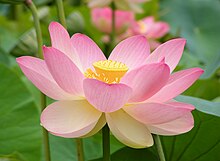| Nelumbo | |
|---|---|
 | |
| N. nucifera (sacred lotus) | |
| Scientific classification | |
| Kingdom: | Plantae |
| Division: | Angiosperms |
| (unranked): | Eudicots |
| Order: | Proteales |
| Family: | Nelumbonaceae |
| Genus: | Nelumbo Adans. |
| Species | |
Nelumbo is a genus of aquatic plants with large, showy flowers resembling water lilies, commonly known as lotus. The generic name is derived from theSinhalese word Nelum. There are only two known living species in the genus. The sacred lotus (N. nucifera) is native to Asia, and is the better known of the two. It is commonly cultivated, and also used in Chinese medicine and cooking. This species is the national flower of Egypt, India and Vietnam. The American lotus (N. lutea) is native to North America and the Caribbean. Horticultural hybrids have been produced between these two geographically separated species. A third, extinct species, N. aureavallis, is known from Eocene fossils from North Dakota, United States.
There is residual disagreement over which family the genus should be placed in. Traditional classification systems recognized Nelumbo as part of theNymphaeaceae (water lily) family, but traditional taxonomists were likely misled by evolutionary convergences associated with an evolutionary shift from a terrestrial to an aquatic lifestyle. In the older classification systems it was recognized under the biological order Nymphaeales or Nelumbonales. Nelumbo is currently recognized as its own family, Nelumbonaceae, as one of several distinctive families in the eudicot order Proteales. Its closest living relatives, the (Proteaceae and Platanaceae), are shrubs or trees.
Contents[hide] |
[edit]Species
- †N. aureavallis Hickey – Eocene (North Dakota), described from leaves found in the Golden Valley Formation in North Dakota, USA.[1]
- N. lutea Willd. – American lotus (Eastern United States, Mexico, Greater Antilles, Honduras)
- N. nucifera Gaertn. – sacred or Indian lotus, also known as the Rose of India and the sacred water lily of Hinduism and Buddhism. It is the national flower ofIndia and Vietnam. Its roots and seeds are also used widely in Asian cooking.
[edit]Classification
Most academic botanists recognize Nelumbo in the family Nelumbonaceae, comprising only the single genus, Nelumbo, with probably two species of aquatic plants, found in North America and Asia (and perhaps some adjacent areas, but widely cultivated elsewhere).
The leaves of Nelumbo can be distinguished from those of genera in the Nymphaeaceae as they are peltate, that is they have fully circular leaves. Nymphaea, on the other hand, has a single characteristic notch from the edge in to the center of the lily pad. The seedpod of Nelumbo is very distinctive.
[edit]APG
The APG II system of 2003, recognizes Nelumbonaceae as a distinct family and places it in the order Proteales, in the eudicot clade.
[edit]Earlier classification systems
The Cronquist system of 1981 recognizes the family but places it in the water lily order Nymphaeales. The Dahlgren system of 1985 and Thorne system (1992) both recognize the family and place it in its own order, Nelumbonales.
[edit]Characteristics
[edit]Superhydrophobicity
The leaves of nelumbo are highly water repellent (superhydrophobic). They have given the name to what is called the lotus effect.
[edit]Thermoregulation
N. nucifera regulates its temperature in order to benefit insects that are needed for it to reproduce. When the plant flowers, it heats its blossoms to above30 °C (86 °F) for as long as four days even when the air is as cool as 10 °C (50 °F). The heat releases an aroma that attracts certain insects, which fly into the flower to feed on nectar and pollen. According to Roger Seymour and Paul Schultze-Motel of Australia’s University of Adelaide, the heat also rewards insects with a stable environment that enhances their ability to eat, mate, and prepare for flight.[2]



No comments:
Post a Comment